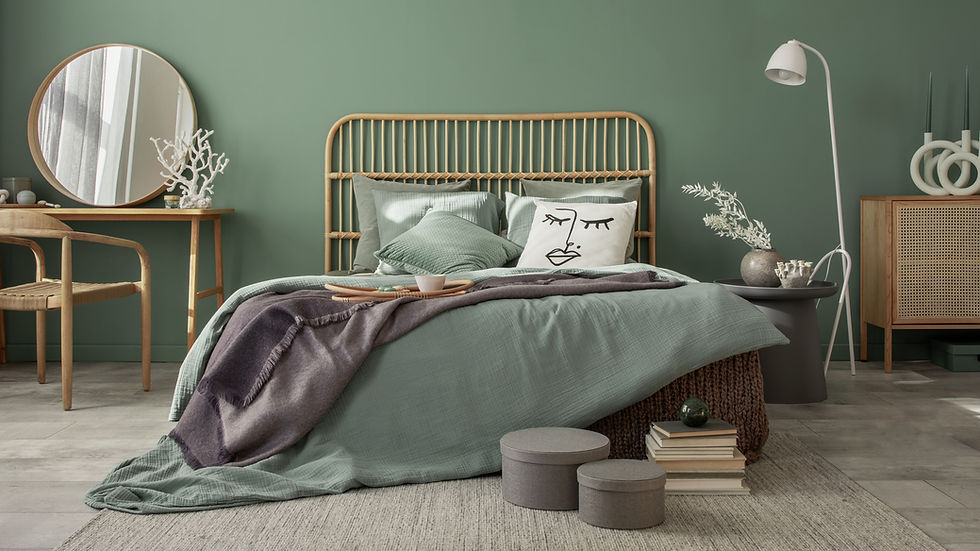Creating Harmonious Interiors: The Art of Balance in Design
- JI Infante
- Jul 24, 2023
- 6 min read
Updated: Aug 4, 2023

Welcome to the world of interior design, where balance is the key to creating harmonious spaces that delight the senses. From the artful pairing of textures and patterns to the graceful dance of furniture arrangement, striking the perfect balance can transform any room into a breathtaking masterpiece.
Join us as we unravel the secrets behind achieving symmetrical, asymmetrical, and radial balance in design. Get ready to unleash your creative prowess and let your interiors shine like never before!
Take a look.
3 Types of Balance

Balance in interior design is all about finding that sweet spot. We've got three types of balance to explore, and they each bring their own unique flavor to the design table.
1. Symmetrical Balance
The poster child of balance, this approach is like that perfectly arranged cheese platter - you can't help but admire its tidy, mirror-image presentation. In symmetrical balance, you split the room into equal halves, giving each side a nearly identical match of furnishings and decor.
For this type of balance, embrace the power of pairs - two sofas flanking a fireplace, matching nightstands on either side of the bed, or identical artwork hung with military precision. It's all about embracing the beauty of perfect symmetry and creating a sense of calm and order.
2. Asymmetrical Balance
For those who like to dance to their own beat, asymmetrical balance is here to shake things up! It's like a whimsical game of Tetris, where different shapes and sizes come together in harmony, creating an intriguing visual puzzle. Who said balance had to be boring?
In asymmetry, balance is achieved through visual weight rather than strict symmetry. You can pair a large, plush sofa with a collection of smaller chairs, or balance a tall floor lamp with a low coffee table.
Just make sure the visual scales don't tip too far in one direction - it's all about keeping the equilibrium.
3. Radial Balance
Picture yourself at the center of attention, like the cool kid at a party. That's exactly what radial balance does to your interior design. It's all about arranging elements around a central point, just like planets orbiting the sun.
Pro tip: Create a stunning focal point at the center, like a grand chandelier or a captivating piece of art. Then, arrange other elements, like furniture or decor items, in a circular or semi-circular pattern around it. It's like drawing everyone's gaze to the heart of your design universe.
3 Elements of Design in Creating Harmonious Interiors

It's time to unlock the secret language of colors and discover how they harmonize to create that perfect melody in your living space.
1. Color Theory and Harmony
Each color is a unique instrument, and it's your job to make sure they play in tune. Color theory is like the magical sheet music that guides you in orchestrating the perfect harmony.
Start with a dominant color as your lead - it sets the mood and vibe for your space. Then, bring in supporting colors, like a backup band, to complement the star of the show.
You can use the classic complementary colors for a bold performance (think red and green), or go for analogous colors for a smooth, soulful blend (like shades of blue and green).
Oh, and don't forget about neutrals, the hues that tie everything together. Add pops of accent colors sparingly, like surprise guest appearances, to keep things interesting.
Just remember, a harmonious color palette is all about finding the right balance and rhythm, so your interior design can hit all the high notes.
Let's say your dominant color is a calming ocean blue. Pair it with sandy beige and soft seafoam green as supporting colors.
Now, throw in some accent colors like coral and turquoise, just like a vibrant coral reef in the ocean. Voila! You've got yourself a harmonious color symphony that brings beachy vibes right into your living room.
2. Textures and Patterns
Now, let's dive into the art of balancing textures and the fearless feat of mixing patterns like a pro.
Creating Texture Balance
Picture this: you walk into a room, and it's like a sensory party for your fingertips. That's the magic of textures!
From smooth velvet to rough-hewn wood, the key is to strike the right balance. It's like finding the perfect ratio - not too much, not too little.
Mix up different textures to add depth and interest. Combine soft textiles, like plush throws and velvety cushions, with hard surfaces, like a rustic coffee table or a metallic side table.
Mixing Patterns
It's time to throw caution to the wind and mix those patterns like a fearless fashionista. Mixing patterns is like a dance-off - it's about complementing each other's rhythm while showing off your individual flair.
Start with a bold pattern as your lead, like a statement wallpaper or a vibrant area rug. Then, invite in supporting patterns that share a color or theme, but vary in scale and style.
3. Furniture Arrangement
You've got the furniture pieces so now it’s time to make sure they hit their marks and steal the show in every scene.
Achieving Visual Equilibrium
Ever seen a lopsided cake that looks like it's about to topple over? Yeah, that's not the kind of drama we want in our interiors. Visual equilibrium is like using a level to make sure everything is perfectly balanced and aligned.
Create balance by arranging furniture in a way that evenly distributes visual weight. If you have a large sofa on one side, balance it out with a substantial bookshelf or an art gallery wall on the opposite side.
Choosing the Right Furniture Pieces
When selecting furniture, you want each piece to have star quality and blend seamlessly with the overall theme. Say no to diva furniture that steals all the attention!
Consider the scale and proportion of your space. For a cozy living room, opt for a comfortable sofa that fits the room without overwhelming it. If you're working with a small bedroom, choose a bed with a sleek frame to maximize space.
Space Planning Tips
Just like a choreographer plans every step of a dance routine, you need to strategize your space for optimal flow and functionality. Space planning is like creating a well-choreographed dance number - you want the furniture to move together in harmony.
Consider your space's purpose and arrange the furniture with that in mind. Create designated areas for different activities, like a reading nook with a cozy armchair and a floor lamp or a dining area with a table and chairs. Oh, and don't forget to leave enough room for easy flow and movement.
2 Principles of Balance in Interior Design

From balancing a sumptuous sofa with tiny trinkets to understanding the gravity-defying magic of visual weight, we'll guide you through the principles that keep your design game on point.
1. Scale and Proportion
In interior design, scale refers to the relative size of elements in a space, while proportion deals with how these elements relate to each other and the overall room. Achieving the right balance of scale and proportion ensures a visually pleasing and well-balanced design.
Balancing Large and Small Elements
When combining large and small elements, it's like matchmaking - opposites might attract, but they need to find their balance.
If you have a grand, high-ceilinged room, don't be afraid to go big with statement furniture, like a tall bookshelf or a large artwork. In smaller spaces, opt for sleek, space-saving furniture to avoid overwhelming the room.
Proportionate Furniture and Accessories
In design terms, we need furniture and accessories that complement each other in size. For example, when choosing a coffee table, make sure it's proportional to the sofa's length.
You don't want a tiny table making your couch look like a giant monster. As for accessories, consider the size of the space; small accents in a large room might get lost in the crowd.
2. Visual Weight
Visual weight can make objects appear lighter or heavier than they really are. Here are some ways to pull off this trick.
Understanding Visual Weight in Objects
Some objects are like a magnet for our eyes, while others are the masters of camouflage. Understanding visual weight is like knowing which objects will be the center of attention and which ones will play the role of wallflowers.
Dark, bold-colored furniture can carry more visual weight than light-colored or neutral pieces, so use them strategically as focal points.
Distributing Visual Weight
In interior design, distributing visual weight is like making sure no part of the room feels like it's doing all the heavy lifting. So, arrange furniture and decor in a way that balances the visual weight throughout the space.
If you have a large, eye-catching artwork on one side of the room, counterbalance it with a group of smaller framed pictures on the opposite wall. It's like creating a symphony of visual harmony, where each element plays its part without stealing the spotlight.
In Conclusion

Congratulations, design enthusiasts! You've now mastered the art of balance, turning your interiors into captivating works of art.
Remember, harmonious spaces are all about finding that sweet spot between colors, textures, patterns, and furniture arrangements. So, go forth and design fearlessly, armed with the knowledge of symmetrical, asymmetrical, and radial balance.
And don't forget to share your design triumphs in the comments below! Follow our page for more design inspiration and let's keep the conversation going.





Comments